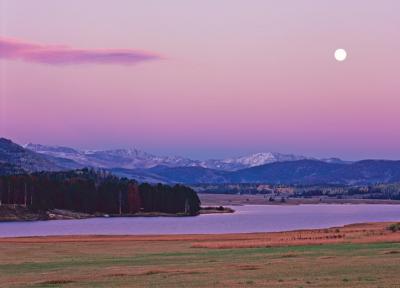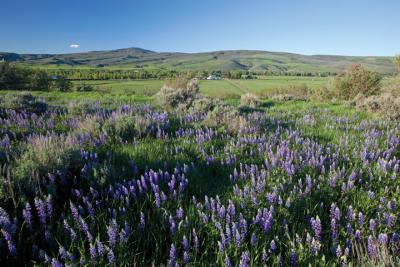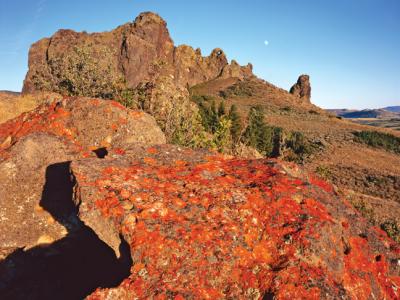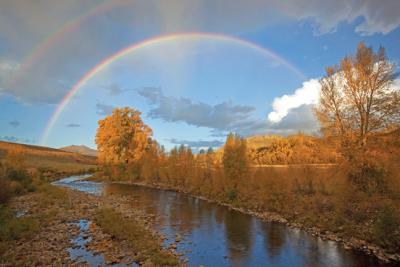Routt County's Land Conservation Crusade
07/01/2011 01:00AM ● By John Fielder
by Jennie Lay; Photography by John Fielder
 Alpenglow over Steamboat Lake and the Fetcher Ranch conservation easement near Clark
Alpenglow over Steamboat Lake and the Fetcher Ranch conservation easement near Clark
Vernon Summer’s modest home is perched just high enough to peer over the bustling fringe of Steamboat Springs and the Yampa River’s expansive south valley floor. It’s a vantage he’s enjoyed all his life. Born and raised at this jag in the railroad and the river, he knows the land intimately.
One long, lazy afternoon over an iced tea, Summer looked out on his lush, 152-acre hay meadow, a part of his family’s ranch since 1889. He spilled forth a lifetime of stories about life and land in the valley – including daunting ski and rafting expeditions that took place long before anyone fathomed a resort.
“Things were never the same after 1970,” Summer said. That was the year the gondola started running at the Steamboat Ski Area. The way land values went up, his neighbors “just couldn’t believe it was so.”
Summer served on Routt County’s inaugural planning commission for a decade, chairing it from 1975 to 1980. He saw Routt County’s first zoning resolution go into effect – and duly noted that not everyone was happy about it. He saw ambitious development plans emerge: First Stagecoach. Then Catamount. Then the Walton Creek Falls proposal at the base of Rabbit Ears Pass, with 2,000 homes, six bridges across Walton Creek and a 40-acre shopping center.
 Purple lupine break the green expanse on a rise above the Carpenter Ranch’s hay meadows.
Purple lupine break the green expanse on a rise above the Carpenter Ranch’s hay meadows.
He spoke with great deliberation about the early planning days, expressing no regret about quashing sprawl in the south end of the valley. “If you had people scattered all up this valley, you just wouldn’t want to be here,” he said. “I believe in keeping it open space.” He stood behind his word. Summer placed his family ranch in a conservation easement with the Yampa Valley Land Trust in 1997. It was an early demonstration project for Routt County’s groundbreaking Purchase of Development Rights program – proving the system would work. “I didn’t want to develop it anyway,” Summer said. “The only thing you can count on is change. But all this open space will be the same.”
As of July 2011, Routt County landowners have put approximately 96,162 acres of private land into conservation easements. That’s 6.7 percent of the county – open land preserved forever for agriculture, wildlife habitat and views from the gondola. By the end of next year, that total will eek close to eight percent as projects in the pipeline proceed.
Keeping the momentum strong
Neither the last decade’s record breaking rise in real estate prices nor the recession has slowed the pace: About half of these acres were conserved during the past six years.
“This is like conservation heaven over here. You’re a community that stepped up, especially for agricultural land,” says Chris West, executive director of the Colorado Cattlemen’s Agricultural Land Trust, which works statewide. “I have to deal with the jealousy of other counties.”
Mark the change of tide at 1992. That year, Yampa Valley Land Trust opened its doors as Steamboat’s first local land trust, and The Nature Conservancy moved into town. It’s also the year Great Outdoors Colorado was born, offering a new source of land conservation funding via proceeds from the Colorado Lottery.
These days, Yampa Valley Land Trust and The Nature Conservancy are joined in their local efforts by the Cattlemen, Colorado Open Lands, and the Rocky Mountain Elk Foundation, as well as the Division of Wildlife.
These nonprofit organizations work with willing landowners to conserve lands, and are authorized by Colorado and the U.S. to hold conservation easements. A land trust is legally bound to monitor and uphold the terms of the easement in perpetuity.
“I loved the community and the open and natural land surrounding Steamboat,” says Susan Dorsey, founder and executive director of Yampa Valley Land Trust. The proposed Catamount Ski Area development called for 10,000 residents at the south end of the valley. “That wasn’t my vision for the valley,” she says.
Catamount as such never came to be. Conservation easements reducing density by 99 percent were among the Yampa Valley Land Trust’s first projects. “I love the organization. It’s always been a leader. We take on the big jobs,” Dorsey says.
When Routt County voters approved the creation of PDR in 1996, a perfect storm for conservation was formed. PDR offers a funding source (via a 1.5 mill Routt County property tax) to purchase willing landowners’ development rights. It’s a critical bargaining tool for attracting other conservation dollars to the valley, since PDR money typically leverages matching grants, including GOCO. In 2005, voters restated their long-range vision, renewing the PDR program through 2025.
PDR is “huge,” West says. “No other county does this for ranching.” Often, it only takes a little bit of money to leverage a lot – and sometimes it’s just covering the transaction costs, enabling land-rich, cash-poor landowners to get the deal done.
Forethought, and a ripple effect
The Yampa Valley has proceeded holistically, says photographer John Fielder, who helped write the 1992 legislation that created Great Outdoors Colorado. His photographs – including iconic ones of the Yampa Valley – stoked passion for passing the initiative.
“A lot of these ranchers did this at the risk of scorn from their neighbors. It’s a beautiful thing,” Fielder says, hailing conservation as an investment not only in ecology, but a long-term sustainable economy.
The Heid family of Triangle 3 Ranch in Clark is still guiding horseback rides on its conserved property. John Weibel is giving local food production a run on the Elk River Valley’s historic McDermott Ranch, conserved land that’s home to Moon Hill Dairy and Firefly Mountain Produce. The Legacy Ranch at U.S. 40 and Colorado 131 is headquarters for Yampatika’s environmental education program. The Gay family on Green Creek Ranch in Pleasant Valley conserved exceptional trout habitat on the Yampa, where fishermen are happy to pay for access.
And most conserved land in Routt County is still growing cows, sheep and hay too.
In 1995, GOCO awarded planning money to the Yampa River Legacy Partnership, a diverse collection of government entities, land trusts, ranchers, business and recreation advocates with a common goal of protecting the Yampa Valley. More than $10 million in grants followed, leveraging tens of millions of dollars in local land protection and public access projects.
Now that partnership is revitalizing to approach President Obama’s America’s Great Outdoors initiative for conservation and recreation. Interior Secretary Ken Salazar and Gov. John Hickenlooper pegged the Yampa River Basin as a priority area. “This is a chance to re-invigorate the Legacy group and add in the youth component – get kids on the ground and build future conservationists with a connection to the outdoors and the land,” Dorsey says. “We’ve got to pass the baton on to somebody,”
Relying on landowners“No matter how you look at it, it wouldn’t have happened without the passionate landowners,” Dorsey says. The appraised value of Yampa Valley Land Trust’s 27,729 acres of Routt County conservation easements alone is over $172.5 million, adjusted to 2011 prices.
Dorsey marvels at ranchers like Summer; Elaine Gay and her son, Bill, at Green Creek Ranch in Pleasant Valley; the Fetcher family in Clark, and Dean Rossi in Yampa, who talk about their land – and the chance they took to protect it – with heartfelt emotion. These early easement-holders have been some of the community’s biggest cheerleaders, A Rossi Ranch hay meadow at harvest she says: “It’s been a wonderful opportunity to work with some very wonderful people.”
“You need to do it because you really want to conserve your land. This is a very small piece of the larger picture,” Dorsey says, noting a range of considerations from estate planning to family dynamics that come into play. Her advice to all landowners contemplating a conservation easement: “Think about it. Think about it seriously.”
 Volcanic intrusions create signature outcroppings on the Rossi Ranch near Yampa.
Volcanic intrusions create signature outcroppings on the Rossi Ranch near Yampa.
A conservation easement is permanent, and it can take years to sort out the details. The late Dean Chestarted the process in 1992. The pieces finally fell into place for the family and their ranch near Clark last year, resulting in a 770-acre conservation easement.
These voluntary legal agreements permanently restrict development rights. They allow landowners to continue to use, sell and pass on their land, but forever eliminate subdivision and most development rights. They do not require public access. They do offer tax breaks, including Colorado’s transferable state income tax credit. And sometimes cash payments are available – but that is generally less than half. Landowners donate the balance.
“Concrete and pavement were going to eat up these prestigious mountain communities and the agriculture,” says rancher Bill Gay. “Conservation is good at every price. Especially in these places.” Ranchers and farmers, he says, had to set the pace, be the trendsetters: “We have the water and the soil.”
Leading by ag’s example“You guys are the pioneers in the state,” says Chris Leding, GOCO’s communications director. The Rossi Ranch in South Routt County was the first agricultural conservation easement GOCO funded. “Everybody in the state looks to you. Now everything just ties together – it connects. It’s been such a great story and it’s been so fun to watch.”
The Nature Conservancy was drawn to the valley because of a globally rare riparian forest along the Yampa River, a combination of narrow leaf cottonwood, box elder and red osier dogwood. In the mid 1980s, it helped secure the Yampa River Preserve across from the Carpenter Ranch near Hayden as part of the wetlands mitigation for Stagecoach Reservoir. Then the conservancy purchased the Carpenter Ranch outright, and added a conservation easement that is held by Yampa Valley Land Trust.
“The Carpenter Ranch is the centerpiece of our work here in the Yampa Basin,” says Geoff Blakeslee, TNC’s Yampa River project director. “We’ve really been focusing on our opportunities where we can create a larger, un-fragmented landscape. That includes connecting conservation easements and public lands.”
Most recently, that’s been Wolf Mountain Ranch, adjacent to the Carpenter Ranch. At 7,423 acres, Wolf Mountain’s conservation easement is Routt County’s largest. By all accounts, the ranch’s easement acreage is expected to more than double by next year: Another 8,652 acre-easement is approaching completion.  After the storm on the Focus Ranch in the Little Snake River Valley.
After the storm on the Focus Ranch in the Little Snake River Valley.
Wolf Mountain Ranch is a bastion of sensitive wildlife habitat, particularly for grouse, and it is adjacent to several other conservation easements. Ultimately, a conserved landscape of more than 21,000 contiguous acres is growing near Hayden – an effort that includes multiple landowners, three separate land trusts and a score of funding sources. Reports of other pending deals in the area could bump this single block of conserved landscape as high as 30,000 acres.
“It all started with the Carpenter Ranch,” says Brent Romick, Wolf Mountain Ranch’s manager. “It gave us a flagship easement. It’s a real communal effort, this connectivity. Wildlife doesn’t understand fragmentation. Hopefully it’s a challenge to other ranches to go out and preserve more than we have.”
The twist
Right now, Routt County’s biggest possible conservation hurdle involves extraction. Oil, gas and coal are abundant in the western part of the county, and it’s relatively accessible. Mineral rights there are virtually all severed – a quirk of America’s westward expansion that resulted in dividing surface land ownership from ownership of the oil, gas and minerals underneath.
“The real work is coming. It’s in front of us, not behind us,” Dorsey says. “We have the perpetual responsibility to monitor our conservation easements.”
Wolf Mountain Ranch is the county’s first conserved property to actively deal with drillers. “It’s been a challenge, one that’s been needed to be addressed for years,” Romick says. With oil drilling imminent, ranch managers are working to ensure no harm comes to the land.
A test well proved fruitful, and the oil exploration company has honored a wildlife restriction to stay out of the area from March 15 to Aug. 1. Land will be re-vegetated this fall, and plans call for directional drilling.
“Hopefully what we do will be a model for the interface between mineral extraction and conservation values. Routt County has seen them come and go. But we can’t just plan on this being just another oil play. We’re approaching it as if it were worst case scenario,” Romick says.
And there’s an opportunity to demonstrate a new model for sustainable extraction.
“The bottom line is, 50, 60, 100 years from now people can look out and appreciate this landscape,” Romick says. “They won’t know who did it, but that doesn’t matter. The point is that it’s done, and it’s solid.”




